|
|

|
.
  
Features
Update 2020/10/13
Mining in Manitoba Investigation
REPORT FINDS NEW FRACKING PROJECT COULD CONTAMINATE SOUTH MANITOBA'S GROUNDWATER
By Suzanne Forcese
What The Frack Manitoba; Brokenhead Ojibway Nation; the Manitoba Metis Federation; and Jon Gerrard, MLA River Heights, Manitoba, submit requests to the Impact Agency Of Canada for designation of the proposed CanWhite Sands silica sand development as a federal project for the purpose of applying the Federal Impact Assessment Act (IAA)
Alberta based mining company, CanWhite Sands (CWS) is proposing the construction and operation of the Vivian Sand Processing Facility Project, a silica sand processing facility located about 35 km east of Winnipeg, Manitoba.
In new information that has come to light, What The Frack Manitoba (WTFM), has prepared a 47-page report, requesting a federal designation of the project.
“Based on the well drilling information we received from the Province, on 42 wells drilled to date by CanWhite, we found that many were inadequately sealed and some not sealed at all, which could very well lead to E.coli contamination via ground water run-off into the aquifer that supplies potable drinking water to Southeastern Manitoba.”
Don Sullivan, Director What The Frack Manitoba
Should residents of South-Eastern Manitoba and the City of Winnipeg be concerned that they may become victims of Regulatory Negligence by the Province of Manitoba in the event the Province does approve the CWS Proposal? What The Frack Manitoba is presenting scientific data and records to the Minister of the Environment in an attempt to prevent an outcome that has the potential to create a Walkerton scenario.
Twenty years ago heavy rains washed cow manure from a nearby pasture into Walkerton’s water system through a cracked well. The deadly E.coli bacteria made its way into the homes of 5000 residents who drank and bathed in the polluted water.
More than 2300 fell ill, 7 died, and some residents continue to suffer from long term effects such as kidney damage.
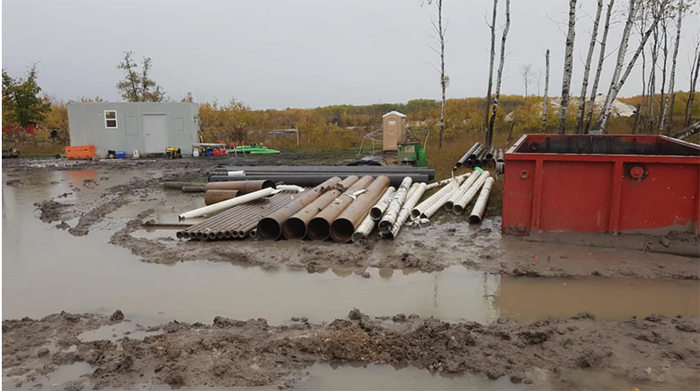
Some of the CanWhite exploration sites have been flooded in the past. The image above, taken in the Spring of 2019, near Vivian,MB., Courtesty Dennis LeNeveu
“Flooding of the extraction sites occurred prior to sealing of many wells. Surface contamination could have entered the aquifers through ungrouted casings during these events.” – WTFM Report
“Such flood events could have introduced fecal and other surface contaminants into the aquifers through the unsealed wells.” – Dennis LeNeveu, biophysicist
WATERTODAY spoke with Don Sullivan, Director of What The Frack Manitoba, who told us their review and analysis of the CanWhite Sands EAP (Environment Act Proposal) identified a number of unresolved issues that were not addressed by the company’s EAP.
“Our position is that these unresolved issues warrant the Federal Government’s involvement in the review of this proposed development project, in a joint Federal/Provincial panel review process to apply The Impact Assessment Act to review CanWhite Sands Processing Facility, and its mine and mining method as one project."
Should the Province approve the proposed processing facility first, the approval of the mine and mining method would be a foregone conclusion “That is backwards,” Sullivan told WT. “We maintain it must be done at the same time. By splitting this one project into two parts, the Province would be allowing the company to avoid the significant expense of preparing all the necessary technical reporting requirements on its mine and mining methods – which could be the most egregious part of this whole project.”
Sullivan points out there are a number of concerns about the mining methods.
The report, prepared by D.M. Le Neveu, biophysicist for WTFM, provides scientific analysis on the implications associated with Drilling Records of CanWhite wells.
On October 1. 2020, What the Frack Manitoba received, from Manitoba Groundwater Management Section, drilling records for forty-two CanWhite Sand Corp wells completed from May 2018 to July 2020.
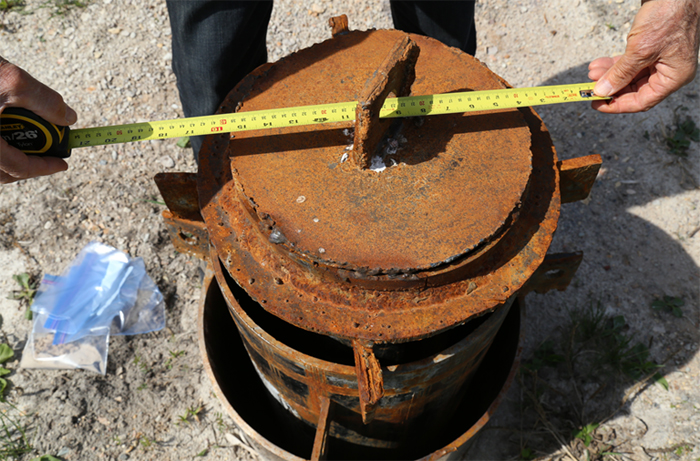
Triple tube well not properly capped and lack of sealing grout on outside of the casing. The well, listed as active and has been capped but no information is given in the well record of sealing. It is in the area where manure spreading is common. In heavy rains entry of fecal matter into unsealed wells is common due to overland flooding. Photo courtesy What The Frack Manitoba
The WTFM Report on Drilling Records of CanWhite Wells states:
- Thirteen of the forty-two CanWhite recorded wells are still active and have not been completely sealed to this date
- Four active wells have no recorded sealing
- The thirty-nine sealed wells have inconsistent sealing methods. The most reliable sealing method using removal of the casing was done in only seventeen of the thirty-nine sealed wells
- Ten wells were sealed between June and August 2020 up to two years after completion, following our complaints about unsealed wells. Most of these wells were observed prior to sealing to have no casing grout. Faulty well caps open to intrusion were observed.
“In addition to the 42 wells drilled by CanWhite there are many more boreholes that were drilled by CanWhite,” Sullivan said. “According to the EPA the project is expected to be in operation for 24 years with a minimum of 100 boreholes per year over the lifespan of the facility. And no one is checking on this.”
Under the Mines and Minerals Act a “borehole” is defined as “a hole that is made in the surface of the ground by drilling or boring and that, for the purpose of exploring for minerals or gathering scientific information, penetrates Phanerozoic rock formations situated above Precambrian rock formations, but does not include a well.”
Sullivan adds that What The Frack Manitoba was unable to obtain data from the province about the boreholes drilled to date because the Mines Branch retains this data.
“We were told this information was confidential and would not be available for review for three years – even though these are abandoned boreholes. How many of these boreholes are properly sealed is anyone’s guess at this stage.”
According to The Mines And Minerals Act (C.C.S.M. c.M162):
“Where a person drills a diamond drill hole through a body of water overlying Precambrian rock, the person shall, upon completion of drilling, plug the hole to prevent movement of water by (a) grouting the entire hole to ground surface using the Tremie technique to place a neat mixture of grout that will produce a minimum strength of 41,000 kPa or (b) using a mechanical plug, securely fastened in competent rock, and Tremie grouting the hole from the plug to bedrock surface with a minimum depth of 15 metres of grout placed as described in clause (a)...
A licensee shall drill and abandon a borehole in such a manner as to prevent the vertical movement of fluids between permeable water bearing zones penetrated by the borehole...
The holder of a borehole licence shall before expiry of the licence, abandon every borehole drilled under the licence by (a) grouting the entire borehole to ground surface using the Tremie technique to place a neat mixture of sulphate resistant (CSA Type 50) grout that will produce a
minimum strength of 41,000 kPA; or (b) using mechanical plugs in combination with Tremie grouting a described in a plan submitted with the borehole licence application to permanently prevent vertical movement of aquifer fluids between permeable water.”
Dennis LeNeveu reported to WT, “The Manitoba Groundwater Section told us that many CanWhite drilled holes were classified as boreholes rather than wells and we would have to get borehole records from Mines Branch. Mines would not even divulge how many CanWhite boreholes were drilled.”
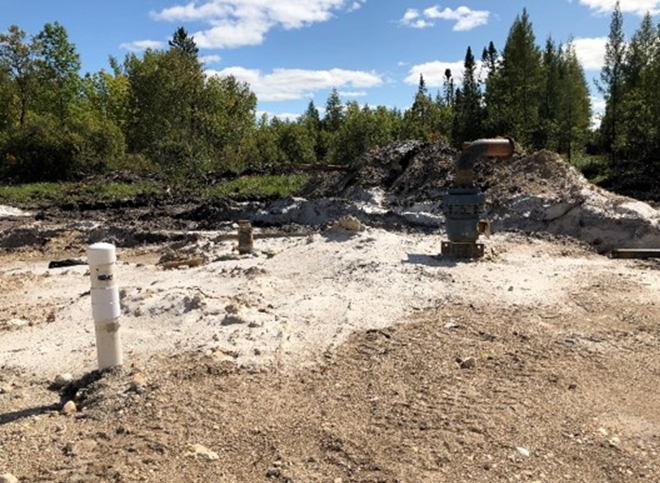
Unsealed Boreholes near Vivian, Manitoba Photo Courtesy What The Frack Manitoba
The Report goes on to state:
- More boreholes have likely been drilled than wells. Many of these boreholes are likely improperly sealed leaving a legacy of potential aquifer contamination. Hundreds more boreholes are planned to be drilled per year that, given the history of improper sealing will lead to aquifer contamination from surface fecal matter and other contaminants
- The record of collapse of two open boreholes in the sandstone formation illustrates that sand pillars will not support excavated cavities. Land subsidence will likely result
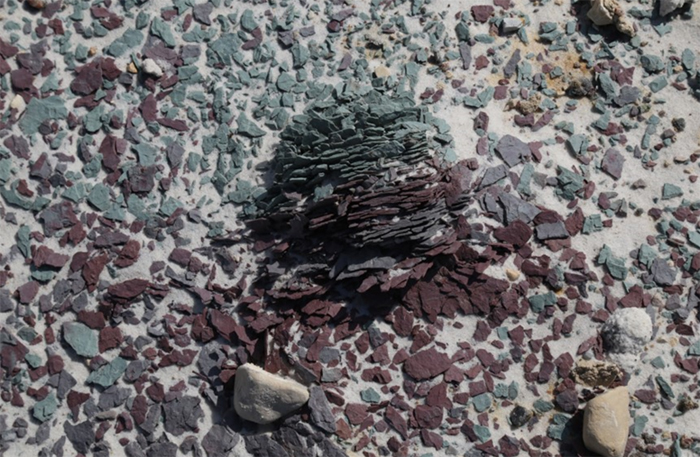
Shale fragments brought to the surface during CanWhite drilling
Photo Courtesy Dennis LeNeveu
The use of shale traps and the gathered shale fragments from extracted sand illustrate that the relatively thin shale aquitard between aquifers is not supportive increasing the likelihood of subsidence
The well records do not show a domed clay cap and earth mounding above abandoned boreholes. Lack of surface expression of the wells and incidents of inaccurate UTM coordinates will result in difficulties in locating wells and boreholes should remediation be required.
LeNeveu adds, “Since there are many CWS wells listed south of Steinbach and around Zhoda – where there are many hog barns and manure spreading is common—any unsealed boreholes in that area could be vectors to contaminate the aquifers.”
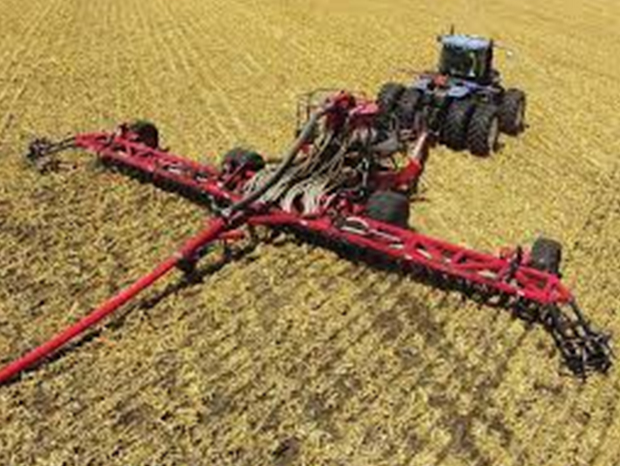
Manure Injector on a farm near Friedensfeld, in Southeastern Manitoba. Many CanWhite wells and boreholes in the same area and further south are in the vicinity of hog barns and lagoons. Photo Courtesy What the Frack Manitoba
“Wherever there are CanWhite wells there are likely to be more boreholes,” LeNeveu continues. “Since no sealing information is recorded for these boreholes there is no incentive to seal because sealing is expensive.”
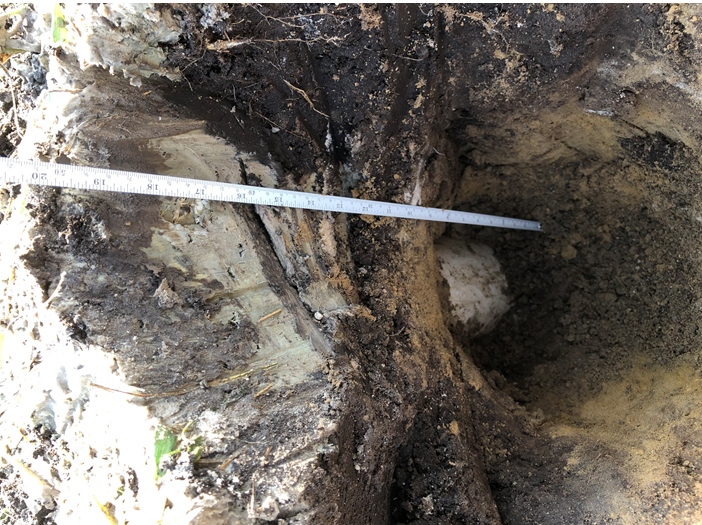
Unsealed excavated borehole in Ross, MB. Photo courtesy Dennis LeNeveu
“As far as we can tell there is no enforcement or inspection of the requirements to seal wells and boreholes. The Mines and Minerals regulation do require boreholes to be sealed. Once the boreholes are cut off, usually up to four feet below ground inspection, it is virtually impossible without excavation. There is a systemic problem with boreholing.” Dennis LeNeveu
LeNeveu adds, “We really don’t know how many boreholes there are, where they are and how well they are sealed. The active but sealed wells will have annular sealing but the inside of the well casing remains open. They can’t be left like this indefinitely.”
The mining method presents yet another concern.
“The proponent is also proposing the construction and operation of the Vivian Sand Extraction Project. Extraction would involve temporary water well drill holes into which air would be injected to flow water and sand to the surface as a slurry. The slurry would be transported to the Vivian Sand Processing Facility using a moveable slurry line, which would be relocated alongside the drilling rigs.” (Manitoba Registry)
On this topic, the Report continues:
- Aerated water returned to the sandstone aquifer from the CanWhite closed slurry loop will react with pyrite in and above the sandstone to form acid. The acid will mobilize toxic heavy metals such as arsenic, chromium and barium contaminating the aquifer
- Formation of acid and mobilization of toxic heavy metals from pyrite in the closed slurry loop will make water recycling impossible
- Drill cuttings and drill fluid from the many boreholes will contain pyrite requiring specialized disposal methods to protect the environment from acid drainage. CanWhite has not disclosed this issue
“The fact that air is injected creates a huge problem,” Sullivan says. “Before the sand is sucked up water is injected. Then these slurry lines have to be moved to the next borehole, and the process is repeated—move, suck sand, drain, move – creating the potential for cracks.”
LeNeveu says, “The slurry pipes can be expected to leak. Pyrite within the slurry pipes would lead to contaminants from pipe leakage being discharged to the land surface and to nearby fish- bearing bodies of water. Slurry pipes cross road ways and many cross the railway. The slurry pipes are likely to eventually cross the Winnipeg aqueduct. Leaks could endanger the Winnipeg water supply. Pipe crossings would be a physical disruption to the aqueduct and the Greater Winnipeg Water District railway. There is federal involvement in the aqueduct that should require federal involvement in the Project assessment.”
Then there is the issue of subsidence.
CEO of CanWhite, Feisal Somji, has stated that “under 5% of the total resource will be extracted using an engineered room and pillar methodology, therefore there are no risks to subsidence.”
In reply to this statement, LeNeveu says, “The sand extracted by CanWhite is unconsolidated. The sand pillars remaining in the aquifer around the extracted voids will likely creep in time and not be supportive. The CanWhite EAP contains no engineering analysis of the potential subsidence.”
“Subsidence could cause many deleterious surface effects such as altering drainage, creating wetlands and providing drain paths for surface fecal matter to enter the carbonate aquifer. Fish habitat, hunting and gathering activities on traditional lands could be disrupted by subsidence.”
By law the Minister of the Environment has 90 days to respond to requests for re-designation.
“We are expecting an earlier response, perhaps as soon as the end of this month,” Sullivan concludes.
suzanne.f@watertoday.ca
|
|
|
Have a question? Give us a call 613-501-0175
All rights reserved 2025 - WATERTODAY - This material may not be reproduced in whole or in part and may not be distributed,
publicly performed, proxy cached or otherwise used, except with express permission.
|
| |